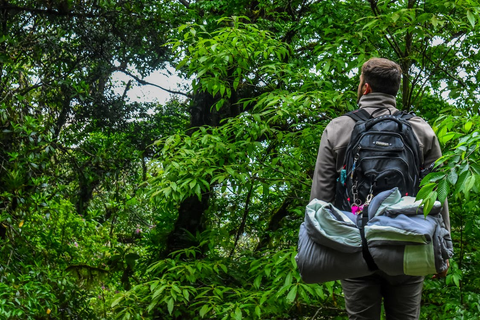Whether you are an experienced hiker, a devoted camper, or a weekend warrior, spending time in the great outdoors can be an exhilarating and rewarding experience. However, it's crucial to prioritize your health and well-being while engaging in outdoor activities. One aspect often overlooked is ergonomics, the science of designing and arranging things to optimize human well-being and performance. Applying ergonomics principles to your outdoor adventures can help prevent injuries, enhance comfort, and make your excursions even more enjoyable. A simple thing such as a comfortable hiking backpack can make a world of difference to the overall quality of your hiking excursion.
In this blog, we will explore the essential dos and don'ts of ergonomics for outdoor adventurers to keep you healthy, safe, and ready for your next thrilling journey.
What is Ergonomics?
Ergonomics, also known as human factors or human engineering, is the scientific discipline that focuses on designing and arranging products, systems, and environments to fit the capabilities, needs, and limitations of human beings. The primary goal of ergonomics is to optimize the interaction between humans and their surroundings to enhance efficiency, safety, comfort, and overall well-being.
The field of ergonomics encompasses a wide range of industries and applications, including workplace design, product design, transportation, healthcare, and more. It considers various factors, such as human anatomy, physiology, psychology, and cognitive abilities, to create environments and tools that promote human performance and reduce the risk of injuries and discomfort.
Ergonomics in The Great Outdoors: An Introduction
When we think of ergonomics, we often associate it with office spaces and workstations, which focus on optimizing efficiency and preventing repetitive strain injuries. However, ergonomics extends beyond the confines of indoor environments and plays a crucial role in outdoor activities as well. Whether you're embarking on a challenging hike, setting up camp, or enjoying a day of fishing by the lake, applying ergonomics principles can significantly impact your comfort and overall experience in the great outdoors.
When you engage in grueling outdoor physical activities such as hiking, ergonomics becomes crucial for ensuring that the hiking gear, equipment, and activities are suited to the physical capabilities of adventurers. Whether it's choosing the right backpack, wearing proper footwear, or maintaining the correct posture during outdoor pursuits, applying ergonomic principles can significantly impact the comfort, safety, and enjoyment of individuals engaging in outdoor adventures.
Ergonomics Dos and Don’ts for Outdoor Activities
As discussed above, applying ergonomic principles during outdoor activities only enhances the experience and ensures physical well-being. Here are some major ergonomics dos and don’ts for your next hiking or camping trip:
1. Choosing The Right Backpacks
DO: Invest in a quality lightweight backpack that fits your body and gear appropriately. Look for padded shoulder straps and a hip belt to distribute the weight evenly across your back and hips. Select a backpack with adjustable straps to customize the fit and ensure maximum comfort during long hikes.
DON’T: Overload your backpack with unnecessary items. Pack only the essentials and distribute the weight evenly to prevent strain and discomfort. Avoid carrying heavy loads on a single shoulder, as it can lead to muscle imbalances and potential injuries.
2. Wearing The Proper Footwear
DO: Invest in high-quality, comfortable hiking boots that support your ankles and arches. Ill-fitting footwear can cause blisters and other foot-related issues, making your outdoor adventure far less enjoyable.
DON’T: Wear new or untested shoes on long hikes or treks. Always break in your hiking boots before embarking on challenging journeys to avoid painful blisters and foot discomfort.
3. Assuming The Correct Posture
DO: Pay attention to your posture while hiking, walking, or engaging in any outdoor activity. Keep your back straight, shoulders relaxed, and your head aligned with your spine. Maintaining proper posture can prevent back pain and improve overall stability.
DON'T: Slouch or lean forward excessively, especially when carrying a heavy backpack. Poor posture can strain your back and lead to muscle fatigue and discomfort.
4. Using Proper Lifting Techniques
DO: Use proper lifting techniques when picking up heavy gear or objects. Bend your knees, not your back, and keep the object close to your body while lifting. Engage your leg muscles to reduce strain on your back.
DON'T: Lift heavy objects with a rounded back or use your back muscles exclusively. Failure to use proper lifting techniques can lead to back injuries and pain.
5. Packing Only The Essentials
DO: Pack only essential items and consider the weight and distribution of gear in your backpack. Organize your equipment in a way that keeps frequently used items easily accessible.
DON'T: Overpack with non-essential items, as it can increase the strain on your body and hinder your mobility during outdoor activities.
6. Using Trekking Poles
DO: Consider using trekking poles, especially during challenging terrains or steep inclines. Trekking poles can provide extra support, reduce stress on your knees and ankles, and improve overall stability.
DON'T: Neglect using trekking poles when they could be beneficial. They are valuable for maintaining balance and reducing strain during outdoor adventures.
Final Thoughts
By following these ergonomics dos and don'ts, outdoor adventurers can prevent injuries and make the most of their time in nature. Remember to prioritize your health and well-being during outdoor activities, and never hesitate to seek professional advice if you experience persistent pain or discomfort.
The major ergonomic principle outdoor adventurers don’t follow is investing in a high-quality lightweight backpack for hiking. Light Hiking Gear provides ultralight hiking gear that makes hiking a breeze and prevents undue injuries or strains that can ruin your outdoor experience. Our lightweight backpacking gear ensures you can walk up the steepest trail without your back being in discomfort. We also have lightweight, portable camping gear for sale that will fit your hiking backpack without ever being a burden. Visit our site now to explore our range of ultralight hiking packs.








0 comments